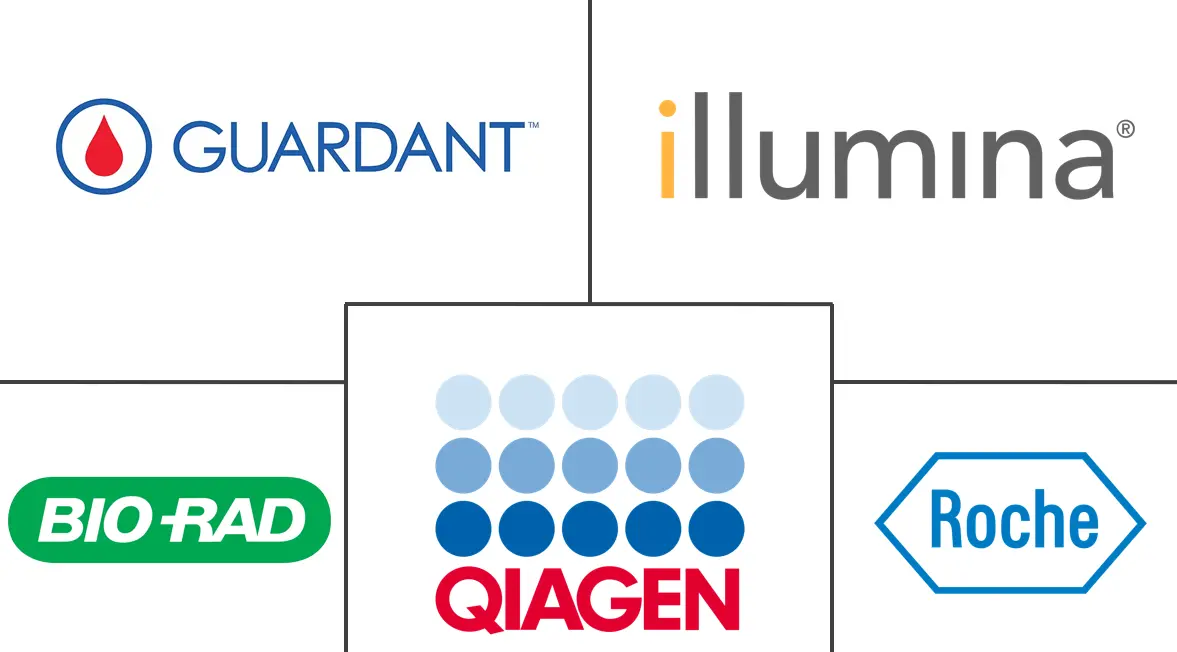Fluid Biopsy Market Size and Share
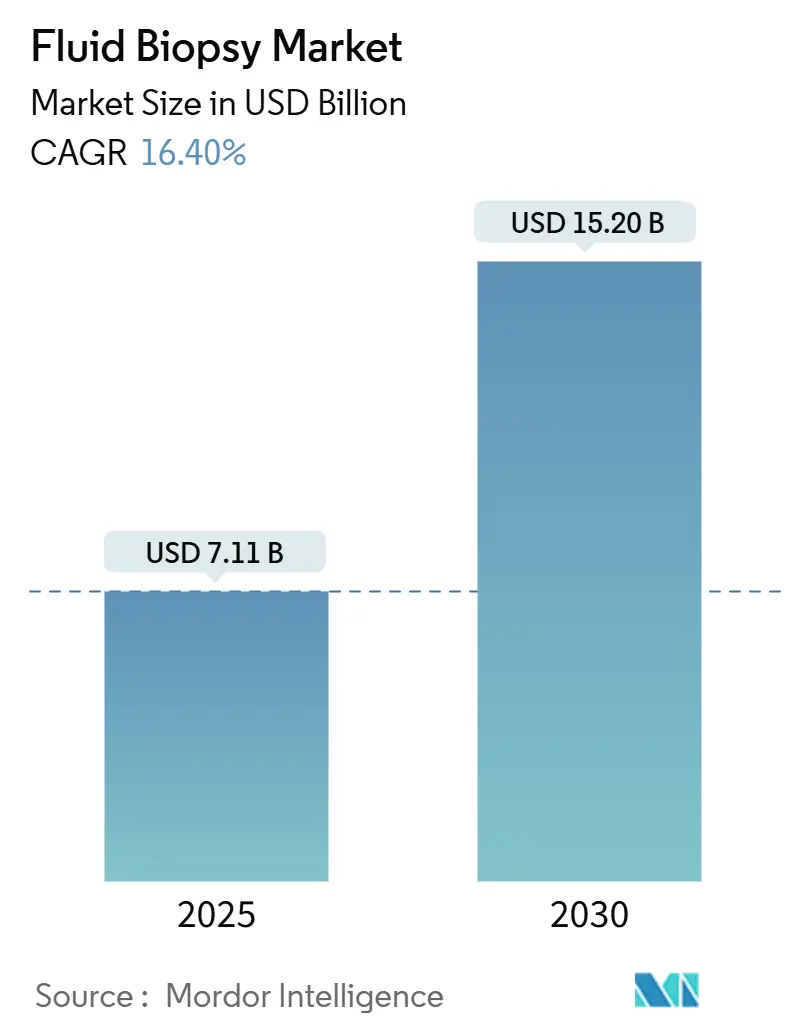
Fluid Biopsy Market Analysis by Mordor Intelligence
The fluid biopsy market size stands at USD 7.11 billion in 2025 and is forecast to advance to USD 15.20 billion by 2030, reflecting a 16.40% CAGR. Rapid AI-guided signal-enrichment techniques, broader Medicare coverage, and multiple FDA breakthrough device designations position fluid biopsies as a routine component of precision oncology workflows. Machine-learning fragmentomics improves detection of circulating tumor DNA (ctDNA) in early-stage cancers, mitigating the low-yield barrier that once limited screening programs. Investment momentum remains strong: single funding rounds now exceed USD 105 million for platform developers that combine next-generation sequencing (NGS) with decentralized automation to shorten turnaround times. Competitive intensity is rising as emerging players deliver software-centric tools that challenge incumbents on sensitivity, price, and scalability. Asia-Pacific’s regulatory agility and large at-risk population create outsized growth potential, while North America retains leadership through reimbursement certainty and research depth.
Key Report Takeaways
- By indication, lung cancer led with 33.55% of the fluid biopsy market share in 2024; pancreatic cancer indications are projected to expand at an 18.25% CAGR through 2030.
- By biomarker, ctDNA captured 45.53% revenue in 2024; extracellular vesicles and exosomes are advancing at a 19.15% CAGR.
- By product & service, kits and reagents dominated with 44.62% 2024 revenue; bioinformatics software posts the fastest 20.12% CAGR.
- By technology, NGS held 67.72% of the fluid biopsy market size in 2024; digital PCR usage is growing at 18.22% CAGR.
- By end user, hospital and physician labs accounted for 38.72% 2024 revenue; reference laboratories record the highest 19.22% CAGR.
- By sample type, blood maintained 67.72% share; urine-based tests are set to rise at an 18.22% CAGR.
- By geography, North America commanded 38.72% of 2024 revenue; Asia-Pacific is poised for a 19.52% CAGR through 2030.
Global Fluid Biopsy Market Trends and Insights
Drivers Impact Analysis
| Driver | (~) % Impact on CAGR Forecast | Geographic Relevance | Impact Timeline |
|---|---|---|---|
| Rising Preference For Non-Invasive Oncology Diagnostics | +3.2% | Global, with early adoption in North America & EU | Medium term (2-4 years) |
| Rapid Increase In Global Cancer Incidence | +2.8% | Global, concentrated in aging populations | Long term (≥ 4 years) |
| Sequencing-Cost Decline & NGS Workflow Automation | +2.1% | APAC core, spill-over to MEA | Short term (≤ 2 years) |
| Reimbursement Expansion For Minimal Residual-Disease (MRD) Blood Tests | +1.9% | North America & EU, expanding to APAC | Medium term (2-4 years) |
| AI-Driven Fragmentomics Boosting Early-Stage Detection Accuracy | +2.5% | Global, led by North America research centers | Medium term (2-4 years) |
| Venture Capital Inflow To Decentralized Fluid-Biopsy Platforms | +1.8% | North America & EU venture ecosystems | Short term (≤ 2 years) |
| Source: Mordor Intelligence | |||
Rising Preference for Non-Invasive Oncology Diagnostics
Patient demand for safer procedures has re-shaped cancer work-ups. Medicare’s 2025 coverage of Guardant Health’s Shield assay validates liquid biopsy utility for routine screening and extends access to Veterans Affairs beneficiaries[1]Guardant Health, “Guardant Health Announces Strategic Collaboration With Pfizer,” investors.guardanthealth.com. Elderly cohorts gain most because tissue biopsy complications rise sharply with comorbidities. Real-time blood-based monitoring allows oncologists to modify therapy sooner than imaging-based schedules, giving fluid biopsy market solutions a complementary role rather than a replacement one. Outpatient clinics adopt the tests quickly because sample collection requires only phlebotomy skills. The trend reinforces decentralized testing demand and underpins recurring reagent revenue.
AI-Driven Fragmentomics Boosting Early-Stage Detection Accuracy
Machine-learning models now interpret fragment length, end motif, and methylation patterns from cell-free DNA to identify early tumors with 92% sensitivity at 90% specificity in non-small cell lung cancer trials. Weill Cornell Medicine’s MRD-EDGE protocol detects residual disease months before radiographic relapse, facilitating pre-emptive therapy switches. Johns Hopkins’ ARTEMIS-DELFI platform provides real-time pancreatic cancer response metrics, addressing a malignancy that historically evaded surveillance. These advances make AI the core infrastructure for future fluid biopsy market platforms. Continuous algorithm training with global data sets will likely widen performance gaps between AI-native and conventional assays.
Sequencing-Cost Decline & NGS Workflow Automation
NGS reagent prices have fallen faster than Moore’s law benchmarks, and Ultima Genomics’ UG100 system further slashes whole-genome costs for 30x coverage. Automation strips out manual pipetting, reducing variability and technician time, which allows regional labs to add liquid biopsy to existing menus without complex validation. Roche’s USD 50 billion US investment commitment underscores a scaling strategy aimed at high-volume, low-cost distribution[2]Roche, “Roche to invest USD 50 billion in pharmaceuticals and diagnostics in the United States,” roche.com. Lower costs unlock large-population screening pilots and accelerate multi-cancer early detection programs inside public health budgets. Standardized workflows also reduce batch-to-batch variability, strengthening payer confidence.
Reimbursement Expansion for Minimal Residual-Disease Blood Tests
Adaptive Biotechnologies’ clonoSEQ obtained an updated Clinical Laboratory Fee Schedule rate of USD 2,007, confirming robust reimbursement for MRD testing. Similar positive coverage determinations in Europe indicate harmonizing payer views on outcome-linked diagnostics. Reimbursement certainty allows laboratories to invest in equipment and recruit specialized personnel, expanding test availability in regional cancer centers. Evidence showing reduced chemotherapy cycles and earlier intervention supports cost-effectiveness claims, encouraging further policy alignment. Sustainable payment structures drive broader adoption, especially in community oncology networks.
Restraints Impact Analysis
| Restraint | (~) % Impact on CAGR Forecast | Geographic Relevance | Impact Timeline |
|---|---|---|---|
| High Test Cost & Reimbursement Hurdles | -2.1% | Global, particularly in emerging markets | Medium term (2-4 years) |
| Emerging Optical-Biopsy & Imaging Substitutes | -1.3% | North America & EU advanced healthcare systems | Long term (≥ 4 years) |
| Pre-Analytical Sample-Handling Variability | -1.7% | Global, concentrated in decentralized settings | Short term (≤ 2 years) |
| Low Ctdna Yield In Early-Stage Tumors | -2.3% | Global, affecting screening applications | Medium term (2-4 years) |
| Source: Mordor Intelligence | |||
High Test Cost & Reimbursement Hurdles
Comprehensive liquid biopsy panels still average USD 2,800 per use, challenging adoption in systems with constrained oncology budgets. Health-economic models indicate prices must drop by two-thirds for second-line colorectal screening to reach cost-effectiveness thresholds. Payer review cycles remain lengthy, demanding robust clinical-utility evidence rather than analytical-validity data. Emerging markets face additional currency fluctuation risks that complicate budgeting for imported reagents. Until scalable manufacturing achieves double-digit cost reductions, uptake outside premium tertiary centers may remain modest.
Low ctDNA Yield in Early-Stage Tumors
Early tumors shed scant DNA, lowering detection sensitivity in screening contexts where intervention benefits are highest. Signal-enrichment algorithms and multi-analyte approaches alleviate but do not fully solve this limitation. Population-level screening pilots thus focus first on high-risk cohorts to mitigate false negatives. Research consortia now investigate extracellular vesicles, microRNAs, and tumor-educated platelets to provide additive sensitivity. Implementation timelines hinge on securing regulatory approval for these novel biomarkers, which may stretch into the medium term.
Segment Analysis
By Indication: Lung Dominance and Pancreatic Momentum
In 2024, lung applications generated 33.55% of overall revenues, consolidating leadership through multiple FDA-cleared companion diagnostics that guide EGFR, ALK, and MET inhibitor therapy selections. The fluid biopsy market benefits from well-mapped mutation profiles and the clinical necessity of repeat testing at progression, which boosts reagent pull-through. Pancreatic programs, although starting smaller, post an impressive 18.25% forecast CAGR on the strength of AI-enabled response monitoring platforms that deliver actionable insight within days. Broad payer support for therapy-selection panels encourages hospitals to integrate liquid biopsy into baseline staging protocols.
Real-world data show breast and colorectal oncology teams now add blood-based surveillance between imaging cycles, cutting average radiology utilization by 15%. Prostate cancer indications gain traction after BRCA-positive metastatic castration-resistant approvals expanded testing beyond genomic labs to urology clinics. Ovarian and gastric trials progress steadily as multi-omics assays uncover epigenetic signatures absent in mutation-centric panels. Adoption diversity across tumor types helps cushion revenue cycles against single-indication reimbursement headwinds and keeps the fluid biopsy market on a stable expansion path.
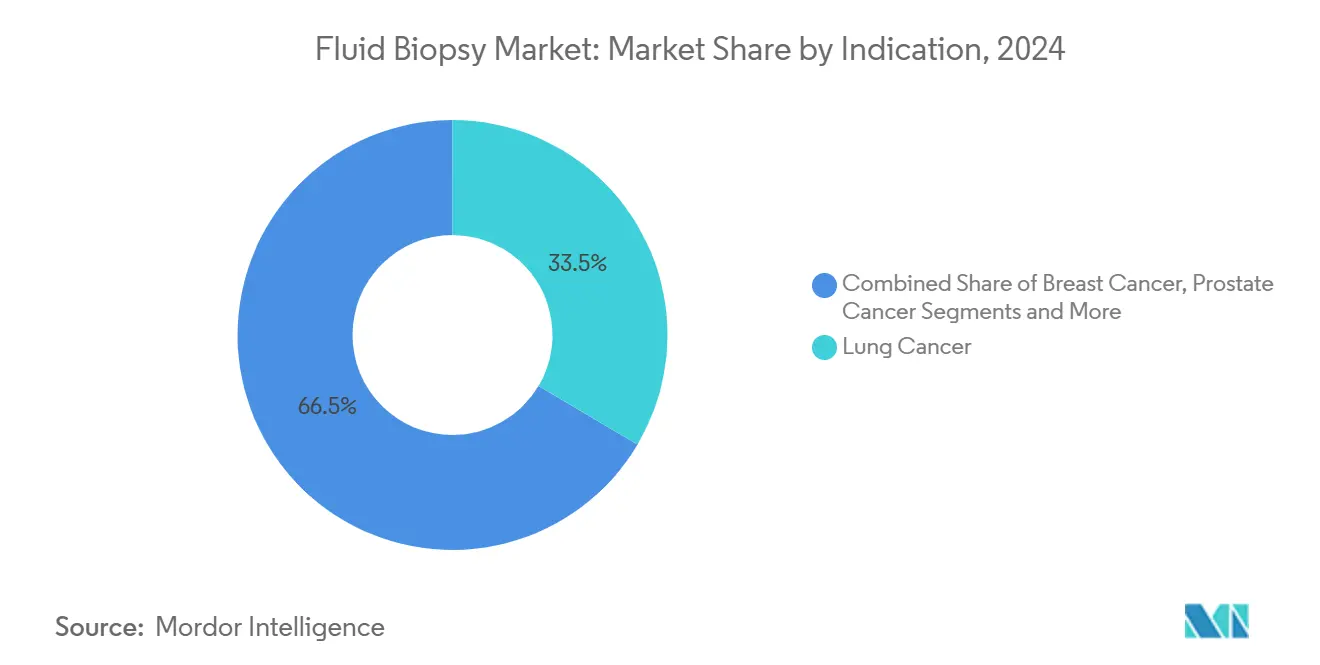
Note: Segment shares of all individual segments available upon report purchase
By Biomarker Type: ctDNA Strength and Vesicle Upside
ctDNA supplied 45.53% of the 2024 biomarker revenue, reflecting a decade of cumulative clinical validation and regulatory clearance. However, vesicle-based assays are scaling at a 19.15% CAGR because lipid membranes protect analytes from degradation, yielding higher analytical sensitivity in Stage I diagnoses. Combined protein and RNA cargo analysis inside exosomes supplies orthogonal data that improve false-positive discrimination. Multi-analyte tests pairing ctDNA with vesicle metrics push positive predictive values into imaging-equivalent ranges without procedural risks.
Circulating tumor cells hold niche relevance for phenotyping metastatic progression, while microRNA signatures supplement histology-agnostic programs. Integrative AI pipelines now fuse fragmentomics, methylation, and vesicle-cargo data, enabling tissue-of-origin predictions with sub-10-millimeter tumor burden. Investors prioritizing early-detection claims channel capital into vesicle startups, anticipating premium reimbursement for screening code sets once sensitivity hurdles are cleared. The biomarker race diversifies revenue streams, reducing single-analyte dependence and fostering innovation across the fluid biopsy industry.
By Product & Service: Consumable Leadership and Software Upswing
Kits and reagents represented 44.62% of 2024 turnover because every test run consumes extraction cartridges, library prep reagents, and sequencing consumables. High recurring-use elasticity makes consumables the economic backbone of the fluid biopsy market. Yet software and bioinformatics now compound at a 20.12% CAGR as laboratories outsource pipeline analytics to cloud platforms that enable real-time quality control. Subscription-based models generate predictable revenue and facilitate rapid deployment of algorithmic upgrades without hardware swaps.
Instruments maintain steady sales inside core pathology labs but face elongated replacement cycles. Testing-service contracts grow in clinics lacking internal genomics personnel, and reference laboratories use these agreements to aggregate national specimen volumes. Comprehensive product-service ecosystems yield lock-in advantages, because customers value end-to-end validation frameworks that comply with ISO-accredited workflows. Market entrants focusing solely on consumables risk commoditization pressures unless paired with differentiated software that pushes sensitivity boundaries.
By Technology: NGS Rule and Digital PCR Challenge
NGS contributed 67.72% of all technology revenues in 2024, driven by its ability to interrogate thousands of loci in a single run. Accuracy, read-depth scalability, and continuously falling per-gigabase costs keep NGS the backbone for multi-cancer assays. Digital PCR, advancing at 18.22% CAGR, offers absolute quantification at lower sample input, making it attractive for MRD surveillance when mutation targets are already known. Bio-Rad’s planned acquisition of Stilla Technologies bolsters throughput and multiplexing, positioning digital PCR for cost-sensitive follow-up testing.
Labs frequently deploy qPCR for confirmatory calls where speed outranks breadth. Nanopore sequencing experiments cache real-time field applicability, but read-accuracy gaps still restrict clinical deployment. Hybrid architectures that pipeline targeted digital PCR pre-screens into broad NGS profiling are under validation, promising cost advantages without sensitivity loss. Such workflow flexibility keeps technology choice tied to clinical context rather than vendor lock-in, stimulating demand diversity across the fluid biopsy market.
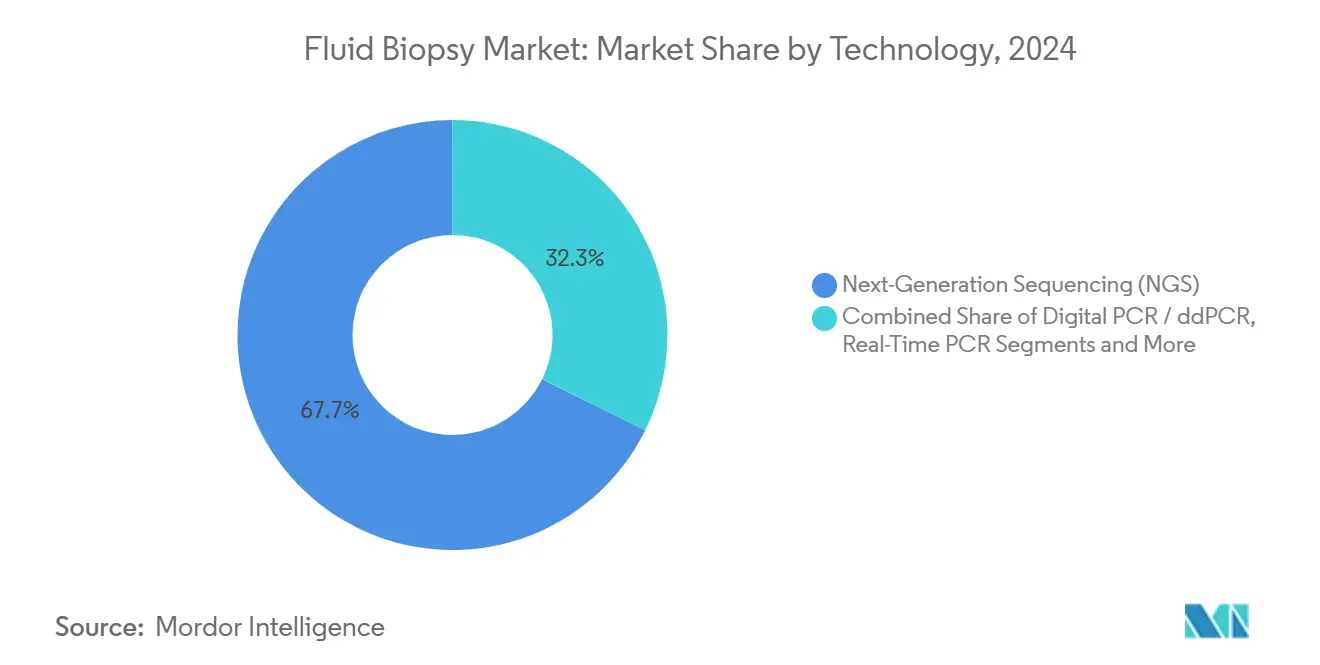
Note: Segment shares of all individual segments available upon report purchase
By End User: Hospital Hubs and Reference Lab Surge
Hospital-based molecular labs held 38.72% 2024 revenue because integrated care networks prioritize point-of-care diagnostics for treatment initiation speed. Reference laboratories, projected to outpace all other settings at 19.22% CAGR, leverage scale to negotiate reagent pricing and deliver complex analytics nationwide. Strategic partnerships between NeoGenomics and Adaptive Biotechnologies illustrate how specialist labs extend reach by pooling sales channels and informatics infrastructure.
Academic centers remain R&D epicenters, generating peer-reviewed evidence that underpins payer policy. Pharmaceutical sponsors increasingly place liquid biopsy in adaptive trial designs, fueling sample volume in contract research organizations. Physician-office labs show incremental adoption as turnkey benchtop instruments become CLIA-waived, easing compliance burdens. Diverse end-user profiles necessitate tiered support models, from 24-hour enterprise informatics to simple web dashboards, broadening total addressable demand.
By Sample Type: Blood Core and Urine Emergence
Blood sampling captured 67.72% of 2024 specimen volume because venipuncture requires minimal logistics and has decades of established phlebotomy protocols. The fluid biopsy market size for blood-based assays is forecast to sustain double-digit expansion given its versatility across tumor types. Urine pipelines, growing at an 18.22% CAGR, gain traction in urological malignancies and repeat-sampling wellness programs because collection is painless and home-compatible.
Saliva and sputum assays provide localized genomic insights in head-and-neck or lung lesions when plasma signal is diluted. Cerebrospinal fluid testing supports central nervous system metastasis monitoring, where blood biomarker permeability is limited by the blood-brain barrier. Pleural and peritoneal effusion sampling address mesothelioma and ovarian surveillance niches. Broadening sample-matrix compatibility increases the resilience of the fluid biopsy market against modality-specific constraints.
Geography Analysis
North America controlled 38.72% of global fluid biopsy market revenue in 2024, supported by FDA breakthrough pathways, generous Medicare coverage, and a dense ecosystem of academic–industry collaborations[3]Centers for Medicare & Medicaid Services, “Genetic Testing for Oncology (DL39367),” cms.gov. United States oncology networks absorb the majority of test volumes, while cross-border patients to Canada and Mexico augment regional demand. Ongoing policy efforts to harmonize sample-handling standards aim to reduce inter-lab variability and protect reimbursement levels tied to quality measures.
Asia-Pacific records the fastest 19.52% CAGR through 2030 as China, Japan, and India expand molecular oncology budgets. China’s 2024 approval of a methylation-based liver cancer assay underscores regulatory willingness to catalyze domestic innovation. Japan’s recent companion diagnostic endorsements for targeted therapies reflect sophisticated regulator–industry dialogue that accelerates product cycles. Government-linked manufacturing incentives lower localized reagent costs, further stimulating uptake.
Europe occupies a mature but still expanding position. Harmonized in-vitro diagnostic regulation, coupled with growing evidence packages, prompts national payers to reimburse MRD monitoring beyond pilot programs. Germany, France, and the United Kingdom anchor market demand through comprehensive cancer centers that value integrated genomic reports. Southern Europe and Scandinavia follow via pan-European procurement schemes that cut acquisition costs. Middle East, Africa, and South America remain nascent but demonstrate increasing trial participation, foreshadowing longer-term commercial opportunities once reimbursement pathways formalize.
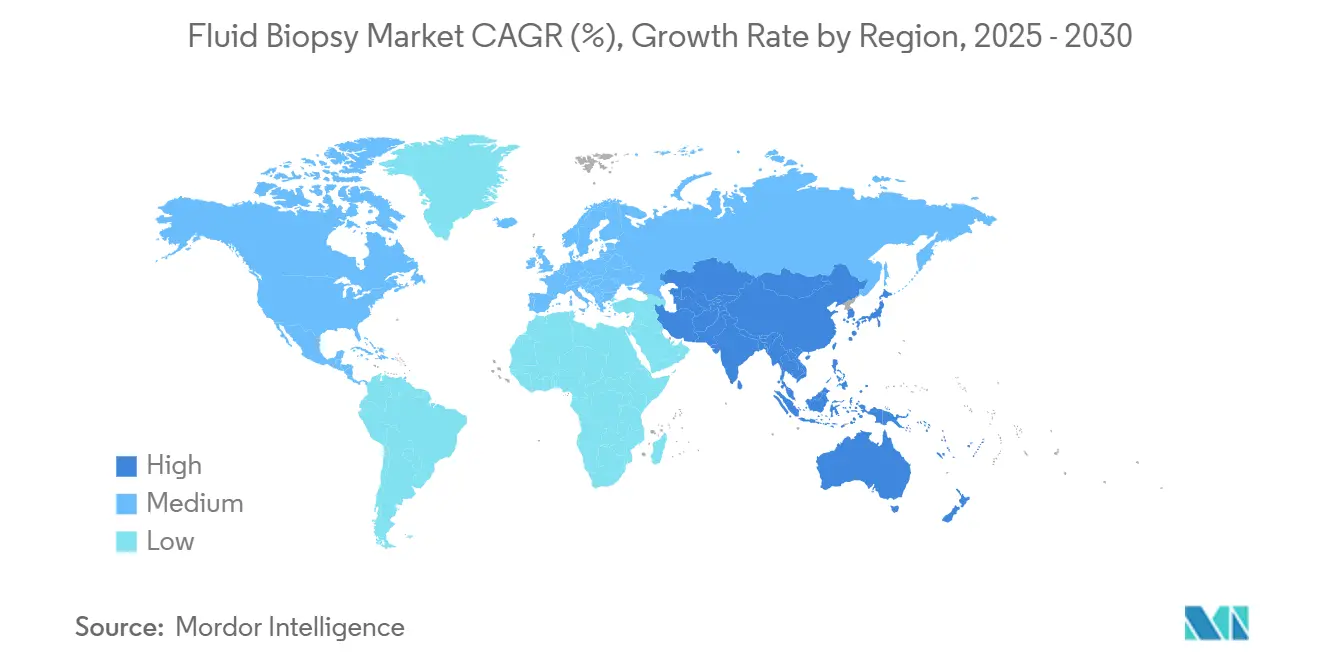
Competitive Landscape
The competitive field displays moderate concentration, with Guardant Health, Roche, and Illumina holding sizable but not dominant shares. Guardant capitalizes on multi-indication FDA approvals and AI software that layers new biomarkers onto the Guardant360 franchise. Roche leverages its diagnostic manufacturing footprint to shorten reagent lead times for hospital clients worldwide. Illumina’s post-GRAIL strategy refocuses on core sequencing innovation while continuing to supply flow cells to third-party liquid biopsy developers.
Strategic partnerships shape the competitive chessboard. Foundation Medicine joined with Fulgent Genetics to introduce germline panels that complement somatic profiling, producing cross-sell synergies. Bio-Rad’s offer to acquire Stilla Technologies signals convergence in digital PCR, consolidating IP and accelerating assay menu expansion. Venture-backed entrants push pricing down by 15% to win contracts in high-volume reference labs, forcing incumbents to expand value-added software and biostatistics services.
Product differentiation hinges on analytical sensitivity, sample-to-answer turnaround, and AI-driven interpretive reporting. Vendors overlay cloud portals that integrate with electronic medical records, reducing clinician friction. Subscription-based informatics unlock sustainable revenue independent of commodity reagent margins. The fluid biopsy industry thus shifts from hardware competition toward data-centric ecosystems that embed deeply into oncology care pathways, making switching costs progressively higher.
Fluid Biopsy Industry Leaders
-
Bio-Rad Laboratories
-
Guardant Health
-
Qiagen NV
-
Roche Diagnostics
-
Illumina Inc.
- *Disclaimer: Major Players sorted in no particular order
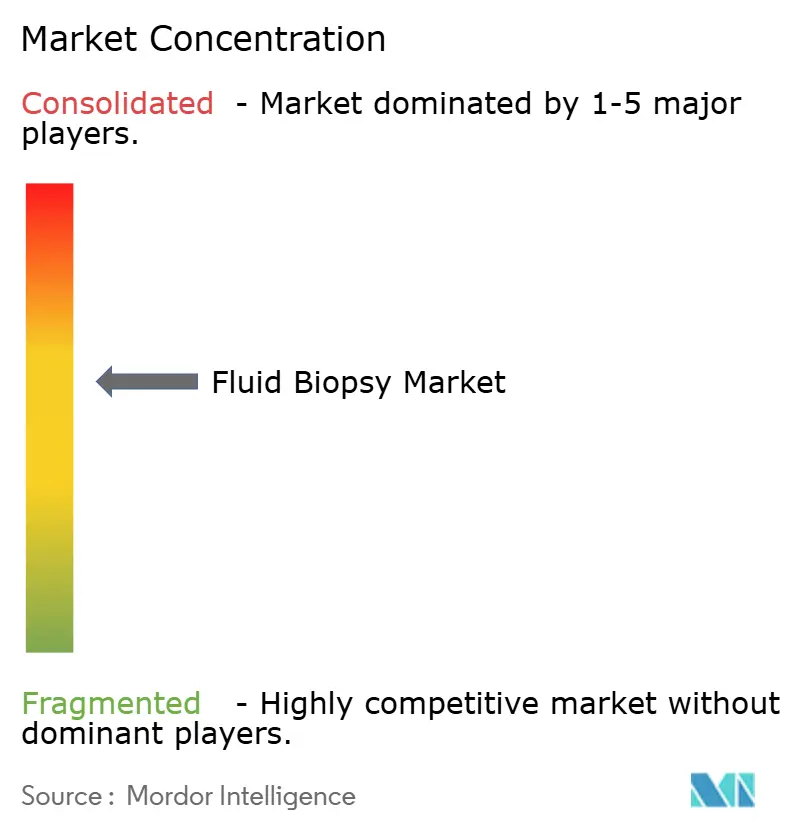
Recent Industry Developments
- May 2025: Guardant Health introduces nearly a dozen groundbreaking smart liquid biopsy applications for its Guardant360 Liquid test, including comprehensive tumor profiling capabilities that confirm absence of actionable mutations and utilize AI-driven biomarker identification to enhance precision oncology applications.
- April 2025: Guardant Health announces strategic collaboration with Pfizer to utilize liquid biopsy portfolio in clinical studies and evaluate circulating tumor DNA for therapy response monitoring, expanding pharmaceutical partnership applications.
Research Methodology Framework and Report Scope
Market Definitions and Key Coverage
Our study defines the fluid biopsy market as all kits, instruments, software, and reference-lab services that capture and interrogate circulating biomarkers, chiefly ctDNA, CTCs, cfDNA, micro-RNA, and extracellular vesicles, drawn from blood or other body fluids to screen, diagnose, and track malignant disease. According to Mordor Intelligence, this activity is valued at USD 7.11 billion in 2025 and spans oncology applications across six biomarker classes and five clinical settings.
Scope Exclusion: Imaging-led optical biopsies, conventional tissue-based histopathology platforms, and non-oncology prenatal or transplant tests fall outside our coverage.
Segmentation Overview
- By Indication
- Lung Cancer
- Breast Cancer
- Colorectal Cancer
- Prostate Cancer
- Pancreatic Cancer
- Other Indications
- By Biomarker Type
- Circulating Tumour Cells (CTCs)
- Circulating Tumour DNA (ctDNA)
- Cell-free DNA (cfDNA)
- Extracellular Vesicles / Exosomes
- Other Biomarkers (miRNA, TEPs, proteins)
- By Product & Service
- Kits & Reagents
- Instruments & Platforms
- Software & Bioinformatics
- Testing Services
- By Technology
- Next-Generation Sequencing (NGS)
- Digital PCR / ddPCR
- Real-Time PCR
- Microarray & qPCR
- Other (Nanopore, Lab-on-Chip, etc.)
- By End User
- Reference Laboratories
- Hospital & Physician Labs
- Academic & Research Centers
- CROs & Biopharma
- By Sample Type
- Blood (Plasma/Serum)
- Urine
- Saliva / Sputum
- Cerebrospinal Fluid
- Other Body Fluids
- Geography
- North America
- United States
- Canada
- Mexico
- Europe
- Germany
- United Kingdom
- France
- Italy
- Spain
- Rest of Europe
- Asia-Pacific
- China
- Japan
- India
- South Korea
- Australia
- Rest of Asia-Pacific
- Middle East and Africa
- GCC
- South Africa
- Rest of Middle East and Africa
- South America
- Brazil
- Argentina
- Rest of South America
- North America
Detailed Research Methodology and Data Validation
Primary Research
To refine assumptions, we hold interviews and short surveys with molecular pathologists, oncology lab directors, kit manufacturers, hospital procurement heads, and payers across North America, Europe, and Asia-Pacific. Insights on average selling prices, test utilization triggers, and regulatory bottlenecks steer model adjustments and validate desk findings before finalization.
Desk Research
We begin with structured reviews of open data sets such as GLOBOCAN cancer incidence, WHO mortality dashboards, OECD health-care spending, and national reimbursement schedules, which ground prevalence and payer dynamics. Trade statistics from UN Comtrade, FDA 510(k) filings that flag cleared assays, and peer-reviewed papers in Nature Medicine or JAMA Oncology help quantify technology diffusion. Company 10-Ks, investor decks, and analyst transcripts add pricing and volume clues, while D&B Hoovers supplies audited revenue splits for leading laboratories. The sources named illustrate our approach; numerous others inform intermediate checks and context building.
Market-Sizing & Forecasting
The core model starts with a top-down build that multiplies cancer incidence by test eligibility ratios, adoption curves, and average test prices. It then reconstructs demand pools by region. Select bottom-up roll-ups of public lab revenues, kit shipments, and capacity utilization act as reality checks. Key variables include global oncology case counts, sequencing cost trajectories, reimbursement coverage expansion, lab throughput benchmarks, regulatory approval cadence, and ongoing clinical-trial volumes. A multivariate regression blended with scenario analysis projects 2025-2030 growth, and gap filling relies on proxy metrics when direct data are unavailable.
Data Validation & Update Cycle
Outputs undergo variance scans against independent cancer diagnostics indices; anomalies trigger re-contact with sources and senior analyst review. Reports refresh every twelve months, with mid-cycle revisions if material events, major approvals or reimbursement shifts, alter baseline drivers.
Why Mordor's Fluid Biopsy Market Baseline Earns Trust
Published estimates often diverge because different firms choose distinct product baskets, biomarker mixes, pricing ladders, and forecast cadences.
Our disciplined scope choice, dual-track modelling, and annual refresh cadence yield a balanced number that decision-makers can trace back to transparent levers.
Benchmark comparison
| Market Size | Anonymized source | Primary gap driver |
|---|---|---|
| USD 7.11 Bn | Mordor Intelligence | |
| USD 4.03 Bn | Global Consultancy A | Excludes lab services and secondary biomarkers |
| USD 13.26 Bn | Industry Outlook Firm B | Includes prenatal, transplant, and pre-approval pipeline revenue |
| USD 11.66 Bn | Insight Publisher C | Uses aggressive price escalation and broader early-detection tests |
This comparison shows that Mordor's carefully bounded scope and validated assumptions deliver a dependable baseline, giving stakeholders confidence that our figures mirror real market activity and not optimistic or conservative extremes.
Key Questions Answered in the Report
What is the current value of the fluid biopsy market?
The fluid biopsy market size is USD 7.11 billion in 2025 and is on track to reach USD 15.20 billion by 2030.
Which cancer indication generates the most revenue for fluid biopsies?
Lung cancer leads with 33.55% fluid biopsy market share owing to multiple FDA-approved tests for targeted therapy selection.
Why is Asia-Pacific viewed as the fastest-growing region?
Regulatory approvals in China and Japan, rising cancer incidence, and expanding reimbursement drive a 19.52% CAGR for Asia-Pacific through 2030.
How does AI improve liquid biopsy sensitivity?
AI-based fragmentomics interprets cell-free DNA patterns, achieving early-stage cancer detection sensitivities above 90%, surpassing traditional mutation-only assays.
What technologies dominate liquid biopsy testing?
Next-generation sequencing controls 67.72% of 2024 revenue, while digital PCR grows quickly for targeted minimal-residual-disease monitoring.
What are the biggest barriers to wider liquid-biopsy adoption?
High per-test costs, complex reimbursement processes, and low ctDNA yield in early-stage tumors remain key restraints despite ongoing technological progress.
Page last updated on:
